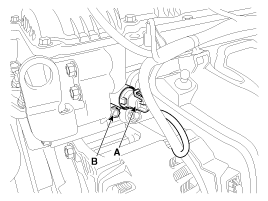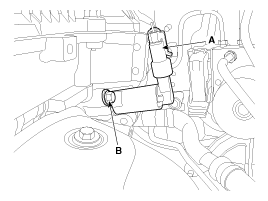Hyundai Tucson: Engine Control System / CVVT Oil Control Valve (OCV) Repair procedures
Hyundai Tucson (LM) 2010-2015 Service Manual / Engine Control / Fuel System / Engine Control System / CVVT Oil Control Valve (OCV) Repair procedures
| Inspection |
| 1. |
Turn the ignition switch OFF. |
| 2. |
Disconnect the OCV connector. |
| 3. |
Measure resistance between the OCV terminals 1 and 2. |
| 4. |
Check that the resistance is within the specification.
|
| Removal |
| 1. |
Turn the ignition switch OFF and disconnect the battery negative (-) cable. |
| 2. |
Disconnect the CVVT oil control valve connector (A). |
| 3. |
Remove the installation bolt (B), and then remove the valve from the engine.
[Bank 1 / Intake]
[Bank 1 / Exhaust]
|
| Installation |
|
|
| 1. |
Install in the reverse order of removal.
|
 CVVT Oil Control Valve (OCV) Schematic Diagrams
CVVT Oil Control Valve (OCV) Schematic Diagrams
Circuit Diagram
(M/T)
(A/T)
...
 Variable Intake Solenoid (VIS) Valve Description and Operation
Variable Intake Solenoid (VIS) Valve Description and Operation
Description
Variable Intake manifold Solenoid (VIS) valve is installed on
the intake manifold. The VIS valve controls the vacuum modulator which
activates a valve in the intake manifold. The EC ...
Other information:
Hyundai Tucson (LM) 2010-2015 Owners Manual: Tire sidewall labeling
This information identifies and describes the fundamental characteristics
of the tire and also provides the tire identification number (TIN) for safety standard
certification. The TIN can be used to identify the tire in case of a recall.
1. Manufacturer or brand name
Manufacturer or brand na ...
Hyundai Tucson (LM) 2010-2015 Service Manual: TPMS Sensor Repair procedures
Removal
Tire Removal
1.
Deflate tire & remove balance weights.
Sensor can be unscrewed before unseating the tire bead.
•
The tire bead should be broken approx. 90° from the valve side of the wheel. The bead breaker should not be set too ...
© 2010-2024 www.htmanual.net



